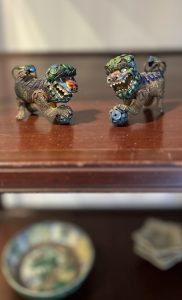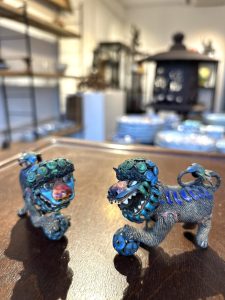小さいながらも迫力のあるお顔です(愛知県名古屋市千種区姫池通 骨董買取 古美術風光舎)
2024.03.12
皆さまこんにちは。スタッフHでございます。
先日、ロサンゼルスで開催されたアカデミー賞で日本の2作品が受賞しましたね。久しぶりに大きなスクリーンで鑑賞してみたくなりました。
さて、風光舎に新しく仲間入りしたこちらの唐物七宝獅子の置物。鋭い歯をむき出し迫力のあるお顔なのですが、目が合うとくすっと笑ってしまうような愛嬌もあります。頭の部分が少し動かせるようになっていて、向きを変えるとまた違う表情を見せてくれます。

横幅が7cmほどの小さな置物ですが、よく見ると細かい部分まで細工が施されており、頭の巻き毛やたてがみ、尾の先や玉に置いた足の形もとてもリアルです。
唐獅子はインドで仏教寺院に最強の動物として設置されていたライオンを元に、ライオンが生息していない中国で生み出された架空の生き物です。美術的装飾的にデザインされ、巻き毛のたてがみを蓄えた勇壮な姿となりました。
獅子をもっと遡ると、エジプトではライオンは王様の力の象徴とされスフィンクスが作られました。また西アジアでは城を守る動物として門に飾られており、中国でも災いから守る動物とされていたとのことです。
日本にも飛鳥時代に仏教と共に伝来し、当初は木造や金属製で神社の本殿や仏殿内部に設置されていたようですが、時代と共に外へと移動し、境内の入り口に置くようになり石造りとなっていったとのこと。
当初は中国と同様に一対の唐獅子でしたが、平安時代ごろより、右側に獅子、左に狛犬を置くようになったそうです。
獅子は口を開け、狛犬は口を閉じた阿吽(あうん)形として「獅子・狛犬」と呼ばれていました。
これは古代日本人が作為的なデザインよりも、自然そのものの姿を尊重し、左右非対称のものを美しいと感じていたからだとされています。そのため中国の伝説上の生き物「獅子」に対して日本独自の架空の生き物として「狛犬」を配置したと考えられています。
ちなみに阿吽とは古代インドのサンスクリット語の始まりの文字が「阿(あ)」、終わりの文字が「吽(うん)」となっており、人生や物事の始めから終わりまで、つまり「この世の全て」という意味になっているそうです。勉強になりました。
さて当初の狛犬は頭部に一本の角が生えていましたが、次第に角のない狛犬も現れ、名前も「獅子・狛犬」から単に「狛犬」と呼ばれるようになっていったとのことです。
唐獅子は他にも獅子舞として日本では馴染みがあります。今ではあまり見かけなくなりましたが、厄払いや豊作祈願の目的で祭りなどに取り入れられ、日本人の暮らしに浸透してきました。風光舎の唐獅子も獅子舞もなぜか愛嬌がある気がするのは、ライオンにの顔にはない立派な眉毛(実はうっすら存在するそうですが)が原因ではないかと思います。
実は眉毛は感情を示す大切な役割を果たしており、眉毛がない表情は感情が読み取りづらくなるそうです。昔の中国人も眉毛を強調することで見る側へ感情が伝わることを理解していたのではと勝手に妄想しております。
さて狛犬に話は戻りますが、その後も獅子と狛犬が左右が逆になったり、狛犬ではなく獅子のみが一対設置されたり、もやは獅子や狛犬ではなく兎、牛、龍、鼠、羊、猿、猪…など日本には多種多様な動物が門番として置かれているようです。なんだかとても日本らしい気がいたします。
狛犬マニアの方もいらっしゃるとのことですので、今後はお参りの際に注目してみようと思います。
それでは、またの機会に。

Hello everyone. This is Staff H.
The other day, two Japanese films won awards at the Academy Awards held in Los Angeles. It has been a while since I have seen them on the big screen.
Now, this Karamono Cloisonne Lion figurine is a new addition to the Fuhkosha. It has a powerful face with sharp teeth, but it also has a charming face that makes you smile when your eyes meet his. The head can be moved a little, and when you turn it around, it shows a different expression.
The curls on the head, the mane, the tip of the tail, and the shape of the feet on the balls are all very realistic.
The Tang Lion is a fictional creature created in China, where lions do not exist, based on the lion that was installed in Buddhist temples in India as the most powerful animal. It was designed for artistic and decorative purposes and became a heroic figure with a mane of curly hair.
Going further back, in Egypt, the lion was a symbol of the king’s power and the sphinx was created. In Western Asia, lions were decorated on gates to protect castles, and in China, lions were also thought of as animals that protected against misfortune.
In the Asuka period (710-794), the sphinx was introduced to Japan along with Buddhism, and was initially made of wood or metal and placed inside the main halls of shrines and Buddhist temples.
Initially, the lions were a pair of Chinese lions, as in China, but from around the Heian period (794-1185), the lions were placed on the right side and the komainu on the left.
They were called “Shi-shi (lion) and komainu (guardian dogs)” in the “A-Un” style, with the lion with its mouth open and the guardian dogs with their mouths closed.
This is believed to be because the ancient Japanese respected the natural form of the animal rather than artificial designs, and they found asymmetrical figures to be beautiful. It is believed that this is why the “komainu” was placed as an imaginary creature unique to Japan in contrast to the “lion,” a legendary creature in Chinese folklore.
Incidentally, the ancient Indian Sanskrit word “A-Un” means “A” for the beginning and “Un” for the end of life, from the beginning to the end, or “everything in the world. I learned a lot.
In the beginning, komainu had a single horn on their heads, but gradually, komainu without horns appeared, and their names changed from “lion and komainu” to simply “komainu” (狛犬).
Karashishi are also familiar in Japan as lion dances. Although they are rarely seen today, they have penetrated into the daily lives of Japanese people as they are used in festivals and other occasions to drive away evil spirits and pray for a good harvest. I think the reason why both Fumikosha’s Karashishi and the lion dance are so charming is because of the magnificent eyebrows (actually, I heard that they even exist), which lions do not have on their faces.
In fact, eyebrows play an important role in showing emotion, and it is said that an expression without eyebrows makes it difficult to read emotion. I have a delusion that the ancient Chinese understood that emphasizing the eyebrows would convey emotion to the viewer.
Now, back to the komainu (guardian dogs). In Japan, it seems that a wide variety of animals are placed as gatekeepers. It seems very Japanese.
I have heard that there are some people who are fanatic about komainu (guardian dogs), so I will pay attention to them when I visit the shrine in the future.
See you next time.
*******************
ご実家の整理やお片付けなどをされている方のご相談などが多くございます。
お片付けなどくれぐれもご無理のないようになさってくださいませ。
風光舎では古美術品や骨董品の他にも絵画や宝石、趣味のお品など様々なジャンルのものを買取しております。
お片付けをされていて、こういうものでもいいのかしらと迷われているものでも、どうぞお気軽にご相談下さいませ。
また風光舎は、出張買取も強化しております。ご近所はもちろん、愛知県内、岐阜県、三重県その他の県へも出張いたします。
まずは、お電話お待ちしております。
愛知県名古屋市千種区姫池通
骨董 買取【古美術 風光舎 名古屋店】
TEL052(734)8444
10:00-18:00 OPEN
#骨董買取#古美術買取#出張買取#無料査定#生前整理#遺品整理#家じまい#実家じまい#掛け軸#絵画#木箱入り茶碗#刀剣#洋食器#貴金属

